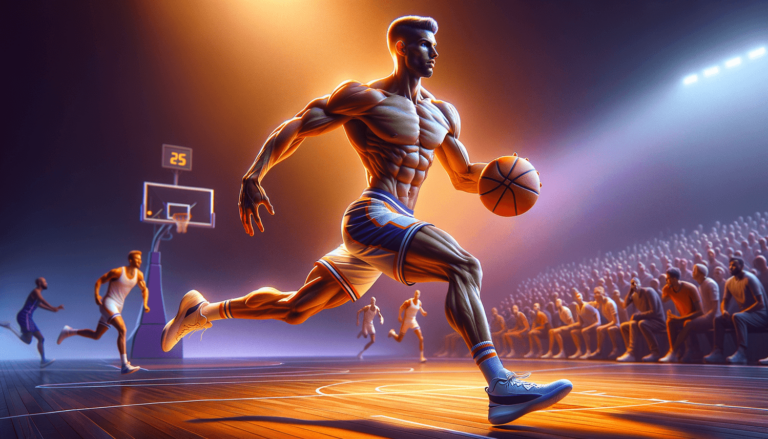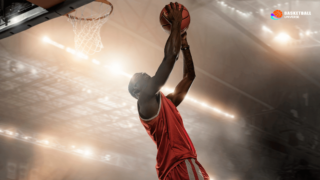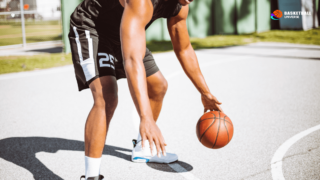
Ever marvel at the lean and muscular physiques of professional basketball players as they race up and down the hardwood? Well, you’re not alone! In the fascinating realm of sports, the seemingly skinny frames of basketball players often pique curiosity. Join us as we dribble our way through the ins and outs of these athletes’ finely-tuned bodies, dissecting the factors that contribute to their awe-inspiring appearance. From rigorous training routines to strict dietary regimens, prepare to unravel the mysteries behind why basketball players are so remarkably slender. So, lace up those sneakers and let’s dive in, shall we?
Why Are Basketball Players So Skinny?
Basketball players appear skinny primarily due to their lean muscle mass and low body fat percentage, which result from intense physical training and strict nutritional plans. These athletes typically require agility and speed, enabling them to excel in the sport. Additionally, their tall stature can make them appear leaner than they actually are. Overall, a lean physique helps players remain competitive on the court by improving their performance, endurance, and injury prevention.
The Importance of Physique in Basketball
In basketball, a player’s physique plays a crucial role in determining their performance. Players must be agile, fast, and capable of performing high-intensity movements throughout the game. Their lean and toned appearance is a product of the rigorous physical demands of the sport. The following sections will examine various factors that contribute to the seemingly skinny profiles of basketball players, including the aspects of genetics, conditioning, and nutrition.
Genetics and Body Structure
Although not every basketball player is born with the perfect genetic makeup for the sport, certain individuals possess a natural predisposition towards a tall and lean frame. At times, the extraordinary height of these athletes can create an illusion of skinniness, even if their muscle mass remains substantial. In this section, we will focus on the role of genetics and body structure in the apparent leanness of basketball players.
Height and Slenderness
Height is a significant advantage in basketball, as taller players often have an easier time shooting, rebounding, and defending against the opposing team. Statistically, the average height of a professional basketball player is several inches taller than that of the general population. This increased stature can create the appearance of skinniness, when in reality, these players still carry a considerable amount of muscle mass.
Fast-Twitch Muscle Fibers
Fast-twitch muscle fibers play an essential role in a basketball player’s performance. These fibers provide explosive strength, allowing for quick bursts of speed, higher jumps, and enhanced agility on the court. Some athletes possess a higher percentage of fast-twitch fibers, which may contribute to a leaner appearance compared to those with more slow-twitch fibers.
Conditioning and Training
Beyond genetic predispositions, basketball players undergo intensive conditioning and training regimens to achieve and maintain their lean physiques. These rigorous programs include a mix of strength, speed, agility, and endurance exercises that not only fine-tune their skills but also contribute to their overall body composition.
Strength Training
Strength training is essential for developing and maintaining muscle mass, which in turn, contributes to a leaner appearance. Basketball players must focus on building functional strength that translates to improved performance on the court. Examples of strength exercises commonly practiced by athletes in this sport include squats, lunges, push-ups, and pull-ups.
Speed and Agility Drills
Speed and agility are critical aspects of a basketball player’s performance, and thus, these athletes dedicate a significant portion of their training to improving these attributes. Drills such as sprints, ladder drills, and cone drills not only help develop a player’s quickness but also contribute to overall body composition by burning calories and promoting the development of lean muscle mass.
Endurance Training
As basketball is a high-intensity sport, players must possess exceptional endurance to maintain their performance level throughout the game. Regular cardiovascular exercises, such as running, swimming, or cycling, help build a strong heart and lungs while promoting a lean physique. These activities also encourage fat loss, further accentuating the skinny appearance of these athletes.
Nutrition and Diet
Another major factor in the lean appearance of basketball players is their focus on maintaining proper nutrition and adhering to specific diets. The optimal dietary regimen for a basketball player depends on their individual needs and goals, taking into consideration factors such as age, body type, and activity level.
Caloric Intake and Macronutrients
To maintain a lean physique, basketball players must consume the right balance of calories and macronutrients. These athletes require a sufficient amount of carbohydrates to fuel their high-energy workouts, as well as protein to support muscle growth and recovery. They also need an adequate amount of healthy fats, which facilitate hormone production and cellular functions. By following these nutritional guidelines and adjusting their caloric intake according to their activity level, basketball players can maintain a lean physique without sacrificing their performance.
Emphasis on Micronutrients
Beyond macronutrients, basketball players must also pay attention to their intake of essential vitamins and minerals. Micronutrient-rich foods, such as fruits, vegetables, and whole grains provide the necessary nutrients needed for optimal health and recovery. Adequate consumption of these micronutrients allows players to stay energetic and maintain a lean body, ultimately contributing to their skinny appearance.
Hydration
Hydration is a crucial aspect of a basketball player’s overall nutrition. Proper hydration helps maintain energy levels, prevents muscle cramping, and aids digestion. Additionally, staying well-hydrated can help them maintain a lean body mass, as dehydration can lead to increased water retention and bloating. Basketball players must ensure they consume enough water throughout the day, particularly before, during, and after games or practices.
Position-Specific Demands
Each basketball position entails unique physiological and performance demands. Consequently, players in different positions often exhibit different body types and muscle development patterns. This section will explore the physical differences across various positions on the court and explain why some may appear skinnier than others.
Guards: Agility and Speed
In basketball, guards are typically the smaller and faster players on the court. Their primary role involves ball-handling, passing, and scoring from the perimeter or off the dribble. These athletes often possess a leaner physique, as their duties require agility, quick reflexes, and coordination. A lower body fat percentage coupled with lean muscle mass enables them to be highly responsive and explosive on the court.
Forwards: Strength and Versatility
Forwards are often characterized by their combination of size and agility. They are commonly tasked with rebounding, scoring from inside and outside, and occasionally assuming ball-handling responsibilities. As a result, forwards require a balance of strength, speed, and quickness, which necessitates a lean, muscular build to fortify their multifaceted performance on the court.
Centers: Height and Power
Centers serve as the backbone of a basketball team and are often the tallest players. They play an essential role in both offensive and defensive plays, including scoring near the basket, shot blocking, and rebounding. Since their primary focus is on maximizing their size and strength advantage, centers tend to possess a more muscular build. However, their extraordinary height can still make them appear relatively lean and skinny.
Advantages of a Lean Physique in Basketball
While the skinny appearance of basketball players is partly due to genetics, the various factors discussed in this post attest to the fact that a lean physique is more than just an aesthetic preference—it is a necessity for optimum performance in the sport. The following are some key advantages that basketball players gain from maintaining a lean frame:
Improved Athletic Performance
Leaner athletes tend to exhibit higher levels of speed, agility, and endurance on the court. Reduced body fat and increased muscle density allow for enhanced mobility and quickness, giving these players a competitive edge over their opponents. Their slim profiles also make it easier to weave through tight spaces and outmaneuver rivals.
Injury Prevention
A lean physique contributes to reduced injury risk in basketball players. Excess body weight can strain joints and muscles, leading to increased incidents of injury. By maintaining a lower body fat percentage and focusing on functional strength training, players are better equipped to avoid injuries and maintain a long and healthy career.
In conclusion, the seemingly skinny appearance of basketball players is no mere coincidence. Rather, it is a product of genetics, conditioning, nutrition, and the unique performance demands of the sport. This lean and muscular physique ultimately bolsters their competitive abilities, providing them with a significant advantage on the court—both in terms of outstanding athletic prowess and injury prevention. So the next time you catch a basketball game, remember that beneath those slender frames lies immense strength, agility, and determination, honed through years of dedication and hard work.
The Role of Recovery in Maintaining Lean Physiques
Another crucial aspect of achieving and maintaining the lean physiques of basketball players is prioritizing their recovery process. It’s crucial for athletes to give their bodies ample time to bounce back after intense training sessions and games. In this section, we’ll explore the impact of various recovery methods and the role they play in sustaining players’ appearances.
Sleep and Rest
Sleep plays a pivotal role in both physical and mental recovery for basketball players. Adequate sleep encourages muscle recovery, reduces inflammation, and supports cognitive functions such as decision-making and reaction times. A well-rested athlete is more likely to maintain a lean physique, as the body is better equipped to burn calories efficiently and manage stress levels.
Active Recovery Days
Active recovery days help basketball players maintain their leanness while simultaneously promoting muscle recovery. Low-intensity activities such as yoga, swimming, or foam rolling can increase blood flow, alleviate muscle soreness, and reduce inflammation without adding excessive strain on the body. By strategically incorporating active recovery days into their training schedules, basketball players can keep their physiques lean and remain primed for top performance.
Post-Game and Post-Workout Recovery
Focusing on recovery immediately after games and workouts further contributes to the lean appearance of basketball players. Utilizing techniques such as stretching, ice baths, and massage therapy can aid in muscle recovery, reduce inflammation, and minimize muscle stiffness. Pairing these practices with proper nutrition and hydration can ensure that athletes effectively replenish lost nutrients and fluids, helping them maintain their lean physiques and reduce injury risk.
Adaptability of Lean Physiques in the Game Evolutions
Basketball has evolved significantly over the years—with a shift towards faster gameplay, more emphasis on perimeter shooting, and positionless playstyles. By maintaining their lean physiques, players can better adapt to these changes and stay competitive in an ever-evolving basketball landscape.
Faster Gameplay and Increased Stamina
Today’s basketball games demand a faster pace, requiring players to possess greater stamina and cardiovascular fitness. Athletes with lean frames have an advantage in this regard, as they can more efficiently expend their energy on the court and maintain their intensity throughout the game. Thus, a leaner build enables players to match the tempo of modern basketball, providing a crucial edge in competition.
Players with More Versatile Skillsets
As basketball leans into positionless play and an increased focus on multi-skilled players, maintaining a lean physique allows for easier adaptation to this shift. Players carrying less bulky muscle mass and body fat are more likely to develop versatile skillsets, enabling them to contribute to their teams in a more significant capacity.
Emphasis on Perimeter Shooting
With basketball’s growing emphasis on three-point shooting, leaner players benefit from the flexibility and range of motion required for accurate shooting. Additionally, their lighter builds allow for quicker movements, enabling them to create open shots or defend the perimeter more effectively. In this way, the seemingly skinny appearance of basketball players is an asset in the current basketball landscape.
By understanding the various factors that contribute to the lean physiques of basketball players—including genetics, conditioning, nutrition, recovery, and adaptability—one can appreciate the critical role this body type plays in achieving elite performance on the court. Ultimately, these slender frames are a testament to the importance of agility, speed, and versatility in today’s fast-paced and constantly evolving game of basketball.
Frequently Asked Questions
If you’re craving further insights into the lean physiques of basketball players or have specific queries related to the topic, explore our comprehensive FAQ section below. We’ve compiled answers to some of the most common questions fans and enthusiasts alike may have regarding the physical attributes of players in this energetic and thrilling sport.
1. Does height make basketball players look skinnier?
Yes, height can make basketball players appear skinnier than they actually are. Since they possess a taller and longer frame, their muscle mass can appear more distributed and elongated, creating a leaner appearance.
2. What is the average body fat percentage of a basketball player?
The average body fat percentage for basketball players varies depending on their playing position and level of competition. Generally, male players have a body fat percentage ranging from 6% to 12%, while female players have a body fat percentage between 16% to 22%.
3. Can a player be too skinny for basketball?
A player can be too skinny for basketball if their low body weight negatively impacts their strength, stamina, and overall performance on the court. In such cases, these athletes may need to focus on muscle building and proper nutrition to achieve a balance between leanness and functionality.
4. How do basketball players build lean muscle mass?
Basketball players build lean muscle mass by following a combination of strength training exercises, speed and agility drills, and endurance training. Additionally, proper nutrition, including adequate protein intake, is essential for promoting muscle growth and recovery.
5. Do basketball players prioritize cardio or strength training?
Basketball players must strike a balance between cardio and strength training. While strength training is crucial for muscle development, cardio exercises help improve players’ stamina and endurance, which contribute to their overall performance on the court.
6. Why do guards seem to be skinnier than other positions?
Guards often appear skinnier because their primary duties on the court require agility, quick reflexes, and coordination. As a result, they maintain a leaner physique, which enhances their speed and mobility during games.
7. Is it necessary for basketball centers to be lean?
While centers may not appear as lean as guards due to their height and mass, maintaining a certain degree of leanness can improve their mobility and overall performance. Excess body fat can hinder their speed and add unnecessary strain on joints and muscles, so a functional level of leanness is advantageous.
8. How much sleep do basketball players need for muscle recovery?
It is generally recommended that basketball players aim for 7-9 hours of sleep per night to ensure adequate muscle recovery and cognitive functioning. Some athletes may require more sleep, particularly during periods of intensive training.
9. What should a basketball player’s diet consist of?
A basketball player’s diet should include a balanced mix of carbohydrates for energy, protein for muscle growth and recovery, and healthy fats for hormone production and cellular functions. Micronutrients, including vitamins and minerals, are also essential for maintaining optimal health and performance.
10. How can basketball players stay hydrated during games?
Basketball players can stay hydrated during games by consuming water and sports drinks at regular intervals throughout the match, particularly during breaks and timeouts. They should also prioritize hydration before and after games to ensure optimal performance and recovery.
11. Do basketball players incorporate yoga or stretching in their routines?
Many basketball players incorporate yoga, stretching, and other flexibility exercises into their routines to improve their mobility, reduce injury risk, and facilitate muscle recovery. These practices can also help develop body awareness, balance, and mental focus.
12. Are there advantages to non-skinny basketball players?
Non-skinny basketball players may possess higher levels of muscle mass and strength, which can be advantageous in certain situations, such as more physical playstyles and post positions. However, maintaining an ideal balance between body mass and functionality is essential for optimal performance on the court.
13. Does body composition vary amongst professional basketball leagues?
Body composition can slightly vary amongst professional basketball leagues due to factors such as regional differences in training practices, nutrition, and gameplay styles. Ultimately, however, the leanness of players remains a significant contributing factor to their overall performances across various leagues.
Featured Posts
- No pillar pages found.




